
THE FRIEND'S SOCIETY
From the History and Directory of Yates County - Volume I, by Stafford C. Cleveland
Published 1873, pg I - VI & 585
Return to Home Page Next Page Friend's Index Page

Part1
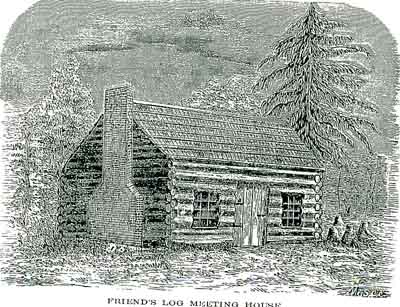
Pg I - VI
Friend s
Log Meeting House- It was to satisfy their
religious aspirations that the Friend and her disciples left their homes in Rhode
Island, Connecticut and Pennsylvania, to found a new settlement, far away from
the comforts and privileges of long settled communities. That Religion was uppermost in their minds, is evinced by
the fact that one of the first acts of the society was to erect a structure for
public worship. They did not wait
for the construction of a costly temple, but made with logs an edifice very
similar to their own rude dwellings. The
sketch of the Log Meeting House, which serves as a frontispiece to this volume,
was drawn from a very minute and careful description of the building by Henry
BARNES, who often attended meeting in it in his childhood, and retains a very
vivid recollection of this figure and appearance. He was able to tell just how many logs could be
counted between the ground and the roof, the number and position of the windows, and
the number of panes in each; the way the doors were hung, how they opened, and
how they were latched. He also
described the chimney and how it was built, and the roof covered with puncheon
and the pine tree standing near. According
to Mr. BARNES, the picture is a faithful reproduction of the actual structure,
which was about 30 by 40 feet in its dimensions. It was in this house that the meetings of the Friends were held for
eight or nine years, except when occasions rendered it more convenient and suitable
to hold them at the house of the Friend. The seats for the congregation were rude benches made
of slabs. The fireplace was a large
open one in which large wood was burned. In
cold weather a huge blazing fire was kept up to warm the room. Frequently the attendance was so large that the meetinghouse was
very much crowded. The same
building was also used as a schoolhouse, and the first public school, as well as
the first public worship, was under its shelter. After the career of the Jesuits in Acadie, there is no doubt this
cheap and simple edifice devoted to religious worship and education was the first
one for either purpose erected west of Fort Stanwix. It well deserved to be held in honorable remembrance, not only for
its sacred and beneficent use, but for the sake of the pious and earnest people
who fashioned it from the trees of the forest and sought religious consecration
under its roof. It stood very near
the site of the Buckley mansion, now owned by James M. CLARK, and close by the
eastern line of the Gore proper; in other words, the New Pre-emption Line.
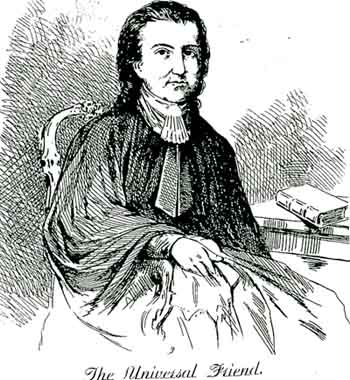
The
Universal Friend- The portrait of the
Friend, presented at page 38, is affirmed by the few aged persons who have seen it,
and who were also familiar with the features of the original, to be a good and
expressive likeness. It represents
the Friend as she appears in middle life, before the bodily infirmities of her
later years had wrought and tendency to coarseness in her physique; while yet
her fine personal symmetry was perfect, and the delicate bloom of healthy
tissues was unclouded in her complexion. The
original work of the artist who had the living form for his inspiration was
somewhat marred by his incompetence, and probably still more by those who
rendered it in the printed engraving. These
defects have been well overcome by hands more deft with the pencil and a brain
endowed with higher capacity to idealize the various descriptive testimonies and
traditions, oral and written, which have been gathered up with much care,
relating to the personal presence of this noted woman. Every picture is at the best but a striking suggestion of its
subject; and this one has proved so perfectly suggestive as to reveal itself at once
to those who have seen both it and its prototype. It will be a source of pleasure to thousands of persons to find in
this book an illustration that represents Public Universal Friend ; the
woman whose career has been so widely bruited and so much distorted by the voice
on ungenerous prejudice; - prejudice formed in sources of contemporary
bitterness, and echoed with subsiding force along the years which compass nearly
two generations since her departure from this world. If there is not in this delineation the most marked suggestion of
that regal quality of her character which gave her ascendancy and authority over
others by force of moral pre-eminence; there is at least an affluent expression
of benevolence and philanthropic feeling which confutes the old detractions and
justifies the generous title she assumed for herself and the assemblage of her
faith.
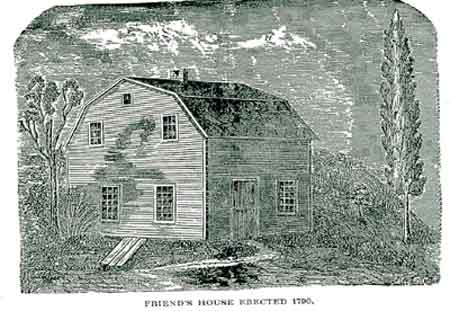
Friend s
House Erected 1790 That this was the first framed house built in Western New York, has
been confidently asserted, and that it was the first after the purchase of Phelps
and Gorham, is probably true. Framed
houses were not unknown among the Senecas, due to their long intercourse with
the French and the advance in civilization awakened among them by the Jesuit
missionaries. Several framed
dwellings were destroyed by SULLIVAN'S soldiers at Canadarque and on the
Genesee during his destructive raid in 1779. This house was a remarkable edifice, considering the time
and circumstances which produced it. An antiquated
relic, it belongs to a time to which we look back, as if to a very ancient period, although a few living persons remember it and its mistress
when she had but just moved away from it to the dense wilderness of Jerusalem,
which she did in 1794. Many curious
recollections cling to this old building. Its
architect and builder was Elijah MALIN, an eminently pious Friend, who was
almost as much identified with the household of their leader as were his
sisters, Rachel and Margaret. He
married the Friend s sister, Deborah, after she became a widow, by the death
of her first husband, Benajah BOTSFORD. The
house was not finished when the Friend arrived in the settlement, and while the
work was going forward, she resided in a temporary structure called the Shingle House somewhat nearer the Lake. The Friend s house when finished, was like a place in comparison
with the humble domicile built with logs, which dotted the surrounding
wilderness, over which the Friend s Settlement extended. The farm on which this house belonged was the property of the Friend
as long as she lived. The house has
usually been kept in tolerable repair, and while its framework and siding had
remained the same, its roof has been once or twice renewed. Its first siding was of plank nailed vertically. It is situated on lot one, of the Friend s lands or Potter location.
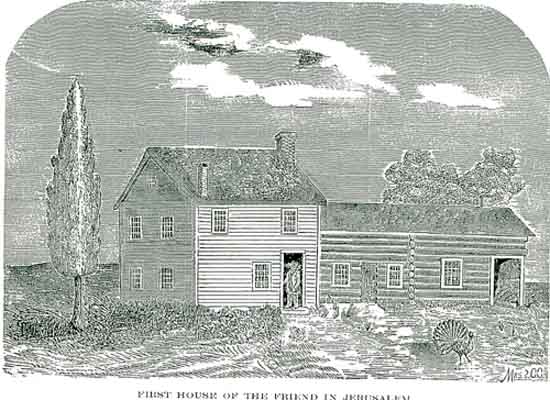
First
House of the Friend in Jerusalem
Till 1803, the Friend s Settlement, including the lands known as the Gore
and eastward to Seneca Lake, belonged in Jerusalem. Since that period, Jerusalem made only be understood
to embrace the town bearing that name. When
the Friend first established her residence in the Second Seventh, it was
in the valley east of her final residence. There she moved into a log house of humble pretensions. To this was added another and then a third. Still later the first part was raised a story higher and sided over,
when it presented the appearance of a frame building as rendered in the picture
present at page 66. The entire
building is drawn precisely as
described by Henry BARNES. In this
abode the Friend and her family resided twenty years, during which period their
fortunes were shaken by many important events. This house stood on the south side of the road, was flanked on the
east by a very fine garden; a few rods south of it bubbled up a noble spring of
excellent water, and still farther in the rear were log barns for farm uses. On the north side of the highway was a long building used
as a workshop by the women, where the spinning and weaving and much of the
sewing was done. The flat on the north
was covered by as fine a sugar camp as ever stood in the county. Within the space of a half mile square, 2,000 maple trees could
be counted. These were large and
thrifty and yielded sap in the sugar making season in wonderful abundance. Henry BARNES relates that he tapped 636 trees in this camp in one
day with an axe and gouge. It was
while the Friend lived in this residence that repeated attempts were made on one
pretence and another, to arrest her, but without success. From this house, Eliza RICHARDS, a giddy girl, the ward of the
Friend, eloped with Enoch MALIN, brining by this and subsequent acts of hers, a
long train of vexatious evils on the Friend and her society. In this house the worship of the society was conducted when the
meetings were held in Jerusalem; though frequently the Friend accompanied by some
members of her household and others of the society went down to the original
settlement and preached on their Saturday Sabbath at the house of Adam HUNT, or that
of Isaac NICHOLS. These journeys
they usually made on Friday afternoon on horseback, and sometimes they formed
quite an imposing cavalcade. When
the meetings were to be at the Friend s house, Silas SPINK, some of the
NICHOLS family and also the HUNTS, and other steadfast Friends would go in
solemn horseback procession to Jerusalem on the preceding day. With their broad-rimmed hats and peculiarly staid demeanor,
riding excellent horses, they always made a notable and highly respectable appearance. Scarce a sign
is left of the domicile which for so many years was the favorite rendezvous for
their devotions. Some years after
the Friend s decease, the building was destroyed by fire.
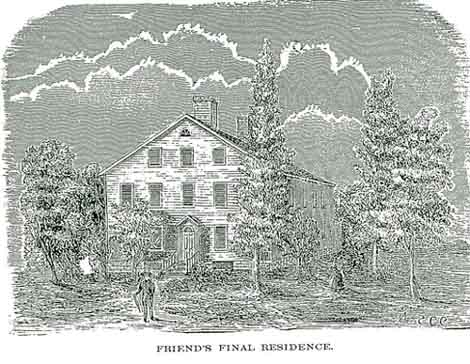
Final
Residence of the Friend
A house designed for a permanent home was not erected by the Friend till a
late period of her life. It was commenced by Thomas CLARK in 1809, and not till
five years later was it finished. The
work done slowly, was also done well. Thomas
CLARK, the architect and builder was from Philadelphia, and his wife was a
sister of Rachel and Margaret MALIN. He
was not a Friend, but a Free Will Baptist of the strictest faith, and aided in
excommunicating James PARKER from that denomination when Mr. PARKER had grown
too liberal in his faith to find the doctrine of endless misery congenial with
his sentiments. Thomas CLARK was a
good mechanic and builder, and whether he build it better or worse in his
theology is not in question here. The
house he erected for the Friend is a structure of historic interest. It was her abode but little more than five years, and during
a considerable portion of that time, she was a declining, suffering invalid. Many interesting meetings of the society were held there, and some of
the most touching in their history. There,
the Friend died; and there died Rachel and Margaret MALIN; also several other
devoted members of the society. There
the hapless sequel of the Friend s will had its melancholy development. There the society, deprived of its head, lost its
steadiness and unity of purpose and came to its end. Most
mournful of all, the needy Friends had not the live long home secured to them,
which by right and by the terms of the Friend s will, was their due. The place with its sadly interesting memories, will always
have associations to challenge the regard of the thoughtful. It was well chosen for a pleasant home. The west arm of Lake Keuka lies in view, and the surround country forms
a beautiful landscape in all directions. Located
on lot 23, of Guernsey s survey, it was eligible as a central situation on the
Friend s domain. Could she have
perpetuated her vigor and equity of judgment in those who followed her in the
control of affairs, it might have long remained a home of interest and happiness
for the household of the Friend s faith. It remains simply a historic landmark, which will probably last
much longer in memory of the people than the strong framework will resist the
ravages of time.
Mausoleum of the Friend. pg xv -xvi
Monumental
vanity had no place in the Friend s theory of human duty. She held
that the living owed their best expenditure of love and labor to the living, and that the dead could be best remembered in
the fragrance of lives consecrated to righteous endeavor. The earliest graves at City Hill are not marked by so much
as the simplest head stone. And in
the Friend's burying ground in Jerusalem, there are no graves designated by
monuments of any kind. Many members
of the Society were there consigned to their final rest; but no inequalities of
their temporal fortune can be inferred from anything that appears above the
common sod under which they repose. At
an early date in the present century, under the direction of the Friend, a vault
for the reception of the dead was placed in the verge of the bank bordering the
valley west of the residence she then occupied. That vault was built by James HATHAWAY, with brick, and was an
arched structure. In that vault
were deposited the bodies of: Thomas HATHAWAY Sr., his brother, James HATHAWAY
and General William WALL. It came
to need repair, and on commencement of the work the arch fell in. The bodies there were then taken to the general burying ground; and at
a later period the burial vault was constructed near the final residence of the
Friend, the figure of which is given at the end of chapter IX. This was built by a mason, whose name was JAYNE, and was designed as
as epulchral deposit for the Friend. For
reasons elsewhere indicated, the body of the Friend was never placed in that
receptable, nor were those of either Rachel or Margaret MALIN. The bodies of the three rest together in a hillock
on that beautiful domain once presided over by the pious leader of the PublicUniversal Friends. It is
most probable that they will never have any other monument than that afforded by
the memory of their lives. It is
perhaps as well so. Shafts of
marble and granite are, at the best, transient and illusive memorials of human
worth. Moral rectitude and faithful devotion to an exalted ideal of duty will
reach higher in the esteem of the future and perpetuate their grateful halo
longer than the chiseled rock will challenge the credulity of posterity. The Friend had better chances of a place in the recollection of
the coming generations than can be traced on the polished stone.
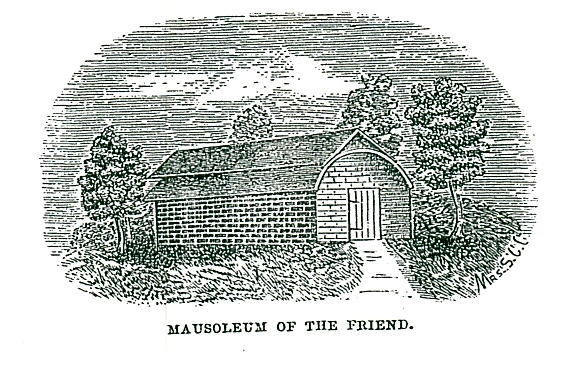
Pg. 585 - The Burial Vault - Soon after 1800, the Friend caused a Burial Vaultto be erected in the bank a short distance west of her residence in the valley. The bodies of Sarah RICHARDS, General WALL, and several others, were deposited there. Not being well constructed, this vault was broken down and destroyed. Subsequently, another was built, near her final residence, of which a sketch is given below. It has not for many year been used as a place of sepulture.
HTML by Dianne Thomas
These
electronic pages may be printed as a link or for personal use, but is NOT
to be reproduced in any format for profit or presentation by ANY other
organization or persons.
2014 Contact Webmaster Dianne Thomas
Copyright 2005 - 2014
![]()